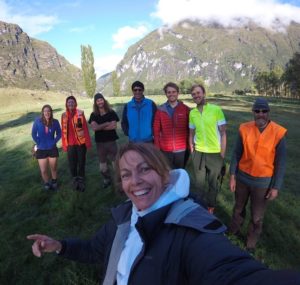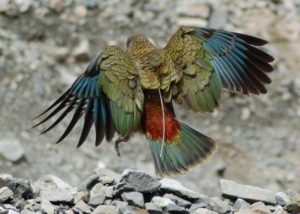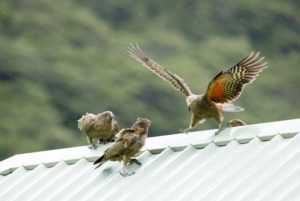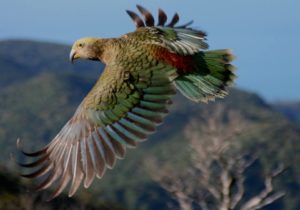When it comes to clever, New Zealand’s alpine parrots are up there with the smartest crows, African Grey Parrots and even monkeys. Kea can problem-solve, use tools and do all the other things that show they’re among the world’s most intelligent non-humans. But, living above the treeline, they’ve evolved to nest among boulders and if a stoat discovers that nest, even our smartest bird is very vulnerable.

The Kea Conservation Trust (KCT) has been looking out for kea since 2006 and this year they’re teaming up with the Auckland Zoo Conservation Fund, Department of Conservation and the Matukituki Charitable Trust to monitor kea nests in the Mt Aspiring area. Tamsin Orr-Walker, co-founder, Community Engagement Officer and Chair of the KCT, says that initially the eight-member Catch Team is aiming to catch adult female kea in the Mt Aspiring area, attach a transmitter to each and follow them back to their nest cavities.
Cameras will then be placed inside and outside the nests so that the nesting process and predator impact can be observed. If there is a predator impact, a network of traps will be put in place to help protect the nesting birds.
The KCT has carried out similar work previously, including monitoring kea in the Nelson Lakes area from 2009 to present day. The first year of the survey showed a decrease in the resident kea population of over 80% since a 6 year study was carried out in the 1990’s by Department of Conservation and Otago University. The KCT study 10 years later showed a decline in resident breeding pairs and predation of any active kea nests. In several cases, stoats killed all the chicks in a nest just before they were due to fledge.
Like other New Zealand native birds, kea don’t have an evolved response to mammalian predators. Stoats, along with possums are the biggest problem, but rats have also been filmed rolling eggs and feral cats have been observed cruising outside kea nests at lower altitudes. Stoats are well able to cope with high altitudes and snowy winter conditions and have been spotted with full ermine (white) coats in high alpine kea habitat. Possums are known to take both kea chicks and eggs.
In the Hawden Valley (Arthurs Pass) nest monitoring has been carried out since 2009. Unlike the Nelson Lakes area, the Hawdon Valley kea benefit from a variety of pest control efforts in the valley. The 2015 season, a beech mast year, was the first year that no chicks were produced in the area – all were lost to predators. A grid trapping network is now planned around active kea nests and should benefit not only local kea, but also the endangered orange-fronted parakeets which also breed in the area.
Even trapping and poisoning predators can have its issues where kea are concerned. Sometimes the birds are just too darned smart for their own good! There are a lot of issues with kea caught in traps, Tamsin says. A variety of traps have caught and killed kea including Timms traps which are lethal for curious kea and there have been issues with Feratox bags – paper bags of cyanide stapled to trees to poison possums. Sentinel and DOC 150/200 traps have also be an issue.
When using DOC 200 traps in kea habitat, the Kea Conservation Trust strongly recommends using long screws – not nails or short screws – on the lid of the box containing the trap. The trap boxes need to be very securely screwed and checked or kea will get in and get killed. “Rocks on top in kea territory don’t work,” Tamsin warns. “If kea flocks are around and trap interference is happening, traps might need to be unset until the flock moves on.” The KCT is putting together an inventory of risks for kea with baits and traps and strongly supports sharing of information on both successful methods and problems, between various groups working in different kea areas.

The ‘Kea Catch Team’ of eight volunteers, including expert kea handlers, recently made its first trip into the east Matukituki area. With limited funds for their work they “jumped onboard Department of Conservation tracking tunnel work in the area”, flying in with DOC staff and helping out with the predator tracking tunnel work in return for some DOC help with the kea.
The work is weather dependent and the team were disappointed not to catch any adult females on that trip, but are planning another trip as soon as weather permits. Then they’ll head into the west Matukituki to check out breeding pairs there.
Kea begin breeding in late June, with fledging occurring until January, so the autumn months are when female kea need to be caught in the lead-up till nesting.
Chicks have a very long juvenile period, with three months till fledging. At 3 years old, they pair off and establish their territory of around 4 square km.
The kea hanging around the skifields this winter will be mostly juveniles – teenagers looking for mischief who have yet to form pair bonds and establish territory. Hopefully the adult females in the Matukituki – suitably adorned with transmitters – will be safely at home raising the next generation of chicks. Kea Conservation Trust promotional video:



